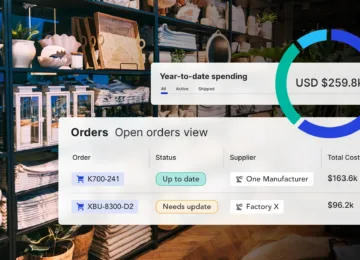In today’s fast-paced and hyper-competitive business landscape, data is the lifeblood of informed decision-making. Whether you’re a small mom-and-pop shop or a global retailer, the ability to gather, analyze, and leverage data can be the difference between success and stagnation.
When it comes to the world of supply chain management and business operations, one of the most transformative tools at your disposal is procurement analytics. Although procurement analytics sounds like a complex term reserved for data scientists and analysts, it’s a concept that holds immense value for anyone involved in the procurement process.
In this blog, we will demystify procurement analytics, why it matters, and how it can revolutionize how your brand manages your purchasing and supplier relationships.
Understanding Procurement Analytics: What Is It?
At its core, procurement analytics is the practice of harnessing data and advanced analytical techniques to gain actionable insights into the procurement process. It involves collecting, processing, and interpreting data related to the procurement of goods and services, supplier performance, purchasing patterns, and various aspects of the supply chain.
Procurement analytics differs from traditional procurement processes, which rely heavily on manual processes, intuition, and historical data. As supply chains become more complex, there’s an urgent need to replace guesswork with data-driven strategies enabled by procurement analytics.
Key Objectives & Benefits
The benefits of procurement analytics are numerous and can substantially impact your brand’s performance. Brands utilize procurement analytics for three primary reasons:
Cost Optimization: A Bottom Line Booster
Procurement analytics helps organizations reduce costs by identifying areas to streamline spending. It offers insights into supplier performance, pricing trends, and purchasing patterns, which better inform negotiations and purchasing decisions. Save costs by identifying inefficient processes, negotiating better prices with suppliers, or consolidating purchases.
Supplier Performance Improvement: Enhancing Partnerships
Effective supplier management is essential for smooth operations. Procurement analytics empowers organizations to evaluate supplier performance objectively. You can nurture stronger relationships with your suppliers by scrutinizing factors such as delivery reliability, quality, and pricing trends. Improved supplier performance translates into enhanced service quality and greater reliability in the supply chain.
Risk Management: Seeing Trouble Before It Strikes
In today’s volatile business environment, risk management is paramount. Procurement analytics acts as a crystal ball, helping you foresee and mitigate potential risks. Analyzing historical and real-time data makes it easier to detect red flags, such as supplier financial instability, geopolitical issues, or supply chain disruptions, well before they impact operations. This early warning system equips your business to address and minimize these risks’ effects proactively.
Getting Started: A Step-by-Step Guide
Procurement analytics is a multifaceted discipline that relies on several critical components, each playing a vital role in the process. These key steps collectively form the core of procurement analytics, enabling your brand to extract actionable insights, optimize your procurement processes, and ultimately achieve your strategic objectives.
1. Define Your Objectives
Begin by clearly defining the objectives of your procurement analytics initiative. What specific goals are you aiming to achieve? Whether it’s cost reduction, supplier performance improvement, or risk management, having well-defined objectives is critical.
2. Data Collection and Integration
Identify the data sources relevant to your objectives, such as purchase orders, invoices, supplier contracts, and historical procurement records. Ensure the data is accurate, complete, and well-organized. Data integration is key, as it allows for a comprehensive view of your procurement ecosystem.
3. Select Your Analytics Tools
Choose the appropriate analytics tools and software that align with your objectives. These may include data analysis platforms, data visualization tools, and predictive analytics software. Many intelligent supply chain technology platforms, like Anvyl’s purchase order (PO) management solution, centralize all the data you need to adopt procurement analytics. Instant access to real-time data and automation capabilities reduce manual data entry and make data collection and analysis more efficient.
4. Analyze Your Data
Apply data analysis techniques to the integrated data. This involves descriptive analytics to understand historical trends, predictive analytics to forecast future scenarios, and prescriptive analytics to recommend actions. Again, modern supply chain technologies streamline your analysis process, helping you uncover cost-saving opportunities, supplier performance issues, and potential risks on one platform.
5. Visualize Your Data
Create dashboards and reports that present the analyzed data in a visually comprehensible manner. These visual representations allow decision-makers to quickly grasp information and trends, facilitating faster and more informed decision-making.
Did you know? You can use Anvyl to create dynamic reports for all stakeholders in the procurement process, giving them a snapshot of the key supply chain data critical to their job.
6. Establish KPIs
Key performance indicators (KPIs) are the yardsticks by which organizations gauge their procurement and supply chain efficiency. These metrics are often specific to an organization’s goals and may include cost savings, supplier quality, on-time delivery, and inventory turnover.
7. Evaluate Your Suppliers
Assess and rank suppliers based on various criteria, including price competitiveness, quality, delivery performance, and risk factors. Practical supplier evaluation contributes to developing strong, mutually beneficial relationships with suppliers and ensures that an organization is partnering with the most suitable suppliers for its needs.
The Future of Procurement Analytics
The field of procurement analytics is constantly evolving, driven by advancements in technology, changing business landscapes, and a growing realization of its strategic importance.
The emergence of AI, for example, is transforming procurement analytics. Machine learning algorithms can already process and analyze vast datasets, identify patterns, predict future trends, and automate routine tasks. As this technology matures, it will become a central component of procurement analytics, improving your brand’s decision-making and efficiency.
Blockchain technology is also gaining traction in procurement for its ability to provide transparency, traceability, and trust in transactions. Three traits are becoming increasingly important to the modern consumer, making their prioritization necessary for brands optimizing their procurement process.
Similarly, your business can use procurement analytics to assess and optimize the sustainability of your supply chains. This includes evaluating suppliers’ environmental and ethical practices and making more environmentally conscious purchasing decisions. In the future, we expect procurement analytics to play an even more significant role in driving sustainability initiatives.
Want to learn more about how Anvyl is helping the world’s fastest-growing retail brands optimize their procurement processes? Contact our team today!



